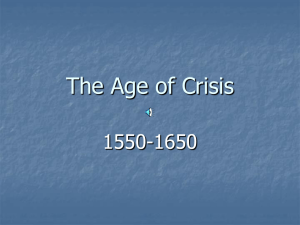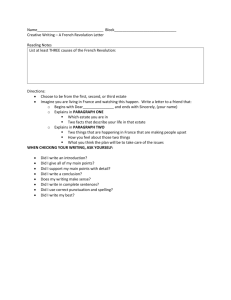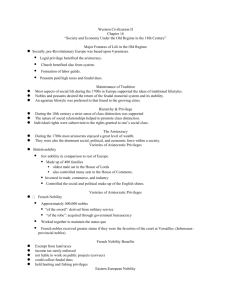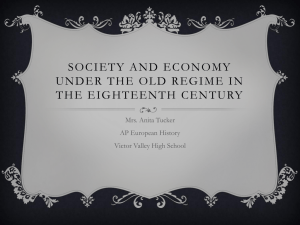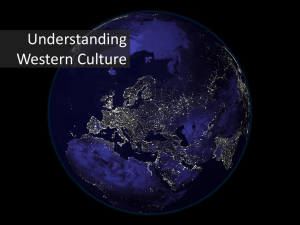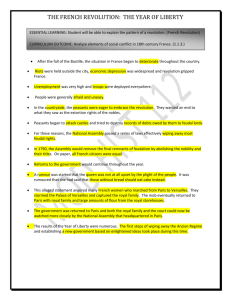Kagan Study Guide - roadrunner-APEH
advertisement
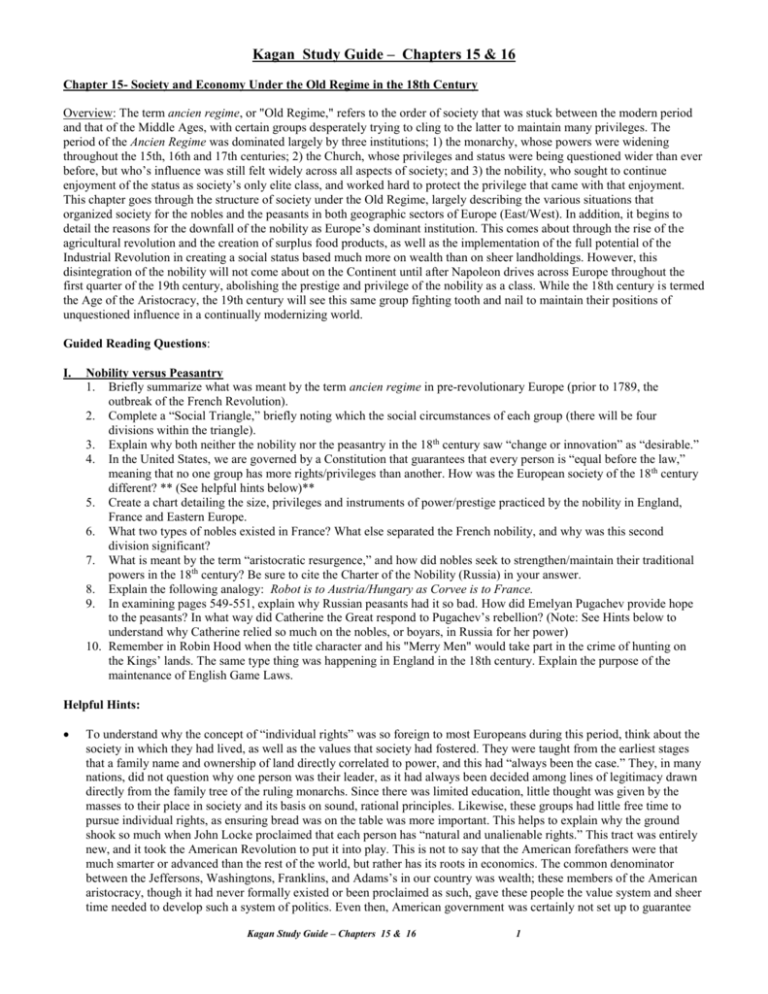
Kagan Study Guide – Chapters 15 & 16 Chapter 15- Society and Economy Under the Old Regime in the 18th Century Overview: The term ancien regime, or "Old Regime," refers to the order of society that was stuck between the modern period and that of the Middle Ages, with certain groups desperately trying to cling to the latter to maintain many privileges. The period of the Ancien Regime was dominated largely by three institutions; 1) the monarchy, whose powers were widening throughout the 15th, 16th and 17th centuries; 2) the Church, whose privileges and status were being questioned wider than ever before, but who’s influence was still felt widely across all aspects of society; and 3) the nobility, who sought to continue enjoyment of the status as society’s only elite class, and worked hard to protect the privilege that came with that enjoyment. This chapter goes through the structure of society under the Old Regime, largely describing the various situations that organized society for the nobles and the peasants in both geographic sectors of Europe (East/West). In addition, it begins to detail the reasons for the downfall of the nobility as Europe’s dominant institution. This comes about through the rise of the agricultural revolution and the creation of surplus food products, as well as the implementation of the full potential of the Industrial Revolution in creating a social status based much more on wealth than on sheer landholdings. However, this disintegration of the nobility will not come about on the Continent until after Napoleon drives across Europe throughout the first quarter of the 19th century, abolishing the prestige and privilege of the nobility as a class. While the 18th century is termed the Age of the Aristocracy, the 19th century will see this same group fighting tooth and nail to maintain their positions of unquestioned influence in a continually modernizing world. Guided Reading Questions: I. Nobility versus Peasantry 1. Briefly summarize what was meant by the term ancien regime in pre-revolutionary Europe (prior to 1789, the outbreak of the French Revolution). 2. Complete a “Social Triangle,” briefly noting which the social circumstances of each group (there will be four divisions within the triangle). 3. Explain why both neither the nobility nor the peasantry in the 18th century saw “change or innovation” as “desirable.” 4. In the United States, we are governed by a Constitution that guarantees that every person is “equal before the law,” meaning that no one group has more rights/privileges than another. How was the European society of the 18 th century different? ** (See helpful hints below)** 5. Create a chart detailing the size, privileges and instruments of power/prestige practiced by the nobility in England, France and Eastern Europe. 6. What two types of nobles existed in France? What else separated the French nobility, and why was this second division significant? 7. What is meant by the term “aristocratic resurgence,” and how did nobles seek to strengthen/maintain their traditional powers in the 18th century? Be sure to cite the Charter of the Nobility (Russia) in your answer. 8. Explain the following analogy: Robot is to Austria/Hungary as Corvee is to France. 9. In examining pages 549-551, explain why Russian peasants had it so bad. How did Emelyan Pugachev provide hope to the peasants? In what way did Catherine the Great respond to Pugachev’s rebellion? (Note: See Hints below to understand why Catherine relied so much on the nobles, or boyars, in Russia for her power) 10. Remember in Robin Hood when the title character and his "Merry Men" would take part in the crime of hunting on the Kings’ lands. The same type thing was happening in England in the 18th century. Explain the purpose of the maintenance of English Game Laws. Helpful Hints: To understand why the concept of “individual rights” was so foreign to most Europeans during this period, think about the society in which they had lived, as well as the values that society had fostered. They were taught from the earliest stages that a family name and ownership of land directly correlated to power, and this had “always been the case.” They, in many nations, did not question why one person was their leader, as it had always been decided among lines of legitimacy drawn directly from the family tree of the ruling monarchs. Since there was limited education, little thought was given by the masses to their place in society and its basis on sound, rational principles. Likewise, these groups had little free time to pursue individual rights, as ensuring bread was on the table was more important. This helps to explain why the ground shook so much when John Locke proclaimed that each person has “natural and unalienable rights.” This tract was entirely new, and it took the American Revolution to put it into play. This is not to say that the American forefathers were that much smarter or advanced than the rest of the world, but rather has its roots in economics. The common denominator between the Jeffersons, Washingtons, Franklins, and Adams’s in our country was wealth; these members of the American aristocracy, though it had never formally existed or been proclaimed as such, gave these people the value system and sheer time needed to develop such a system of politics. Even then, American government was certainly not set up to guarantee Kagan Study Guide – Chapters 15 & 16 1 peoples’ individual rights to a perfect extent, as noted by the absence of non-landowners at the polls on election day and the continuation of the “peculiar institution” of slavery. The term “feudal dues” refers to specific taxes that nobles were allowed to place on their tenants, or the peasants renting lands from them. Typically, a peasant would need to pay some of their yearly produce (a percentage of their crop) to their noble lord as rent. In addition, these peasants might be required to perform duties/service on the nobles’ estates, building roads, irrigation ditches and even working the nobles own personally controlled fields. Another popular measure was to charge the peasants to use the nobles mill to grind their wheat into flour; no peasant could afford their own windmill, so the nobles would take even more of the peasants’ produce when they went to process their small crops. In studying history, it is important to ensure that we use the correct terminology. A serf is a person who is bound to the land upon which they belong. These people, though not technically owned by any person (but rather by the particular plot of land itself), were not allowed to travel, marry or engage in any business without their nobles’ permission. Serfdom continued in eastern Europe until 1861, when Tsar Alexander II freed all the serfs. To contrast this, slavery entails a person as personal property of a specific human owner. A peasant was one who did not own their own land, or who owned only a small tract of land upon which they did subsistence farming (making enough to survive only, with little or no surplus). Peasants were better off than serfs, as they had some sense of legal protection in the countries (though often very little in truth). When describing Western Europe after the 16 th century, it is not usually appropriate to use the term serf, as feudalism was abolished their prior to this (mostly anyways). In addition, another point of confusion will develop later as we look at industrialization and the growth of cities; being a peasant is usually a rural phenomena, whereas being “poor” could signify a wretched life in the city. Catherine the Great was one of the strongest Russian leaders ever, but ironically she was not even Russian by birth. Catherine, the daughter of a German prince, was married to Peter III Romanov. Peter III was largely unfit for strong rule, and he angered many of the nobles and military men by pulling Russia out of the 7 Years War (1756-63; allowing Prussia to make large gains against Austria, which had been Russia’s ally). Following this, Catherine, who never liked her husband at all (she was intelligent and very social, whereas Peter III was very backward and uninformed on proper etiquette), organized a coup. She had her own husband removed from power and she took the reigns herself. Being an “outsider” (a German), she knew from the very beginning that her true power rested on the acceptance of the boyars of her rule. Thus, due to her foreign roots, she needed to keep a happy aristocracy, and this entailed giving them increased rights/privileges. II. 1. 2. 3. 4. 5. 6. 7. 8. Family Life and the Family Economy Compare and contrast the structure of families in Northwestern Europe with those in Eastern Europe. Consider size of households, age of marriage and childbirth, etc. Why would many young people in Europe willingly become "servants?" What is meant by the phrase "the household was the basic unit of production and consumption?" Describe the term "Family Economy," and explain how it differs from the view that all women simply stayed home with the children and cooked/cleaned. The United States today is looking at different forms of Welfare Reform laws. Explain the key rules associated with the Berlin Poor House, and note how it served as a social welfare system. In what ways does Francis Wheatley portray an "idealistic" rural society? What, according to the caption, was ironic/incorrect about this artist’s depiction? What was the central goal/job of women in securing their future? What traditional role was thus made "subordinate" (secondary)? What dangers lay in childbirth in the 18th century? What role did midwives and wet nurses play in regards to children? Helpful Hints: Do Not Fall Into the Trap! Every year, in class discussions or on tests, pseudo-chauvinistic men make the statement that women spent their entire lives chasing children or cooking dinner for their husbands. This is utterly wrong, as it was not the case in the Family Economy. Women played an integral role in the success and prosperity of the family’s finances, and deserve due credit for the role that they played. III. Agricultural Revolution 1. What role did the rising cost of bread have upon the implementation of the Agricultural Revolution? Why do you think nobles were willing to experiment with the new techniques/tools on their large farms while many peasants were unable/unwilling to do so themselves? 2. Why were the Dutch (the Low Countries) involved with the earliest stages of the Agricultural Revolution? What methods did they employ? 3. What role did Tull, Townshend, Bakewell and Young each play in the Agricultural Revolution? (See hints below) Kagan Study Guide – Chapters 15 & 16 2 The English Enclosure Movement is a huge part of that nation’s development as European superpower. Describe what the Enclosures entailed, and explain how this would affect both peasants and nobles. 5. What was the primary reason that population growth rocketed in the 18th century (note the introduction of new crops that could feed large numbers easily)? Helpful Hints 4. Big deal you say, the man used an iron plow. While this seems trivial, it revolutionized farming in northern Europe. The crops of Britain required a strong tilling/plowing of the land every year, and the most effective means of preparing the soil was to ensure that it was properly turned over. By being both heavy and durable, the iron plow allowed English farmers to greatly increase the effectiveness of their fields. The idea of the seed drill created efficiency and effectiveness as well; rather than simply scattering a bunch of seeds throughout an open field and having crops spring up in a disorganized fashion, the seed drill allowed farmers to create organized fields in long lines, rather than in haphazard conglomerations. The idea of crop rotation provided that new crops would be planted on different fields every year. Prior to this, at least one field on every estate had to be left fallow, or unplanted, to ensure that nitrogen and other nutrients would return to the soil. With crop rotation, new plants (clover, turnips, etc.) actually helped the soil keep/regain its nutrients, while also providing more food (fodder) for the farm animals to live on. Thus, not only did crop rotation create more efficient farming, it also helped to increase the meat and livestock available for consumption. Chatper 16: Empire, War and Colonial Rebellion Overview of Chapter: This chapter is relatively brief, but it is a very important transition point between previous chapters and the ones in the immediate future. The central focus is built upon the institutions of colonial control, both economic (mercantilism and colonial trade wars that emerge for dominance of trade and territory) and political (government organization and increased oversight/involvement that lead to many upset colonists). The chapter begins with an overview of mercantilist policy and colonial administration, using the Spanish empire as an example. This showcases the strong role the government in Spain played in all aspects of the life of the Spanish colonies, though it could just as easily be describing the efforts of the British after the 7 Years War. Following this breakdown of mercantilism and colonial policy, it moves towards the development of colonial wars that plagued the European nations during then middle of the 18th century, which created a strong shift in traditional balance of power and spheres of European influence. These wars were fought by professional armies all across the globe, and led to great expenses for the "mother countries." The colonial powers thus needed to increase the taxation upon these colonies, and issues such as this helped lead to the American Revolution, which serves as the culminating event of this chapter’s historical material. Special Note: Geography plays a huge role in understanding this chapter. Please frequently reference maps when reading about the colonial wars, as geographic conditions will help to explain many of the shifting alliances that occur throughout these wars of empire. Guided Reading Questions: I. 1. 2. 3. 4. 5. 6. 7. Mercantilism, Empire and Spanish Administration List the 4 periods of European contact with the rest of the world. What advantage(s) do you believe were most influential in allowing the small continent of Europe to exert such great influence on the rest of the world? Define mercantilism and list the government policies that went along with this economic policy. List the primary areas each of the following nations held as part of its empire: a. Spanish b. English c. French d. Dutch (United Provinces of Holland) What products were most important to the European nations? What areas were deemed the “jewels of the empires”? (remember the video “Factory and Marketplace Revolution”) What two areas experienced frequent competition and conflict among British and French colonists/trade companies? In the one in the eastern hemisphere, how did each country seek to solidify its claims to influence as local government there fell apart? Spanish control of the colonies was administered (governed) from “the top-down,” starting in Spain itself. Create a graphic organizer that shows this distribution of power for both government and economic control. Points to include: Government (Council des Indies, viceroys, audiencias, corregiadors, and reason for primarily using peninsulares) Economic (Casa de Contratacion, flota system, trade monopolies, and trade fairs) Why were Creole members of New Spain and Peru upset with the colonial policies of Spain? What reforms by the Bourbon kings of Spain increased their dissent? (remember these policies and arguments, as they largely mirror those of the American colonists against the British during the same general period) Kagan Study Guide – Chapters 15 & 16 3 8. II. 1. 2. In what various ways did Europeans earn their increased prosperity as a result of Slave labor? Describe the experiences of slaves from their capture in Africa through their eventual work on plantations in the Americas. Wars of the Mid-Eighteenth Century (Wars of Empire) Discuss the role that the Treaty of Utrecht played in the onset of the War of Jenkins’ Ear (1739-1748). Do you feel the British were justified in their declaration of war? Why or why not? Create and complete the following chart with regard to the Wars of the Mid-18th Century: 4. How did the "Diplomatic Revolution" of 1756 shake up the traditional European alliance system? *** See helpful hints for partial rationale of the "switch" 5. Discuss the effects of the 7 Years War and the Treaty of Paris (1763) on Britain, France and Prussia? Who was now (1763) "in the international driver’s seat"? 6. What impact did the wars of the Mid-18th Century, and the Seven Years War in particular, have on European nations’ policies of taxation? How might this affect, say, the British colonies? (wink-wink; think "taxation without representation") Helpful Hints: Remember, geography matters. The good old Hanoverian kings of England have traditional lands in, go figure, Hanover. Hanover is a state in the region of western Germany, close to the French border. In 1756, the Prussians approached the British with a proposition; they proclaimed that an alliance with them would allow for greater protection of the lands in Hanover (Prussia is much closer to Hanover than Austria). Therefore, the British said "sure, we won’t send any troops to the Germanies. This went against their traditional ally, the Austrians (who had a mutual hatred of the French that they shared with the Brits, partially as a result of alliances during the War of Spanish Succession when Louis XIV tried to guarantee French dominance of Europe). The French got very offended (again, go figure) that the Prussians had gone behind their back and signed an agreement with the British, the traditional enemy of the French. The Prussian-British alliance did not automatically end the Prussian-French one, but the French were so mad at the agreement that they broke off ties and then shockingly allied with Austria. What’s so shocking you ask? Try to remember a time when the French and the Hapsburgs got along well. Hapsburg-Valois Wars of the 16th century? Not a chance? How about when Cardinal Richelieu made his entire foreign policy during the 30 Years War one of an entirely anti-Hapsburg nature (he even supported Protestants over the Hapsburgs!). The War of Spanish Succession, where both a Bourbon and a Hapsburg had a claim to the throne of Spain? I think you get the picture… there was lots of animosity between them for over 250 years, but the French were willing to sweep all of that under the rug; in 1756, they hated the Brits more than they hated the Hapsburgs (an enemy of my enemy is my friend?) Kagan Study Guide – Chapters 15 & 16 4 III. 1. The American Revolution Create a descriptive timeline (one that describes events and their impact, not just years) for the following events. A flowchart would work nicely here. 1. 2. 3. 4. 5. 2. 3. 4. 5. Sugar Act (1764) Stamp Act (1765) Stamp Act Congress (1765) Declaratory Act & Repeal of Stamp Act(1766) Townshend Acts (1767) 6. 7. 8. 9. 10. 11. Boston Massacre (1770) Boston Tea Party (1773) “Intolerable Acts” (1774) Lexington/Concord (1775) July 4, 1776 Franklin and France (1778) 1783, Treaty of Paris (a different one than before… 20 years after 1763’s Treaty of Paris ended Seven Years War) What events in Britain served as pre-cursors (events leading up to) America’s fight for independence? What impact did the American Revolution have on Britain in terms of political thought and economic activity? In your opinion, were American colonists dutiful patriots and seekers of liberty who were justified in their demands for independence, or were they largely a bunch of cry babies who just wanted to get their own way and increase their own wealth? Consider: Protection during 7 Years War Tax Rates Representation Role of governments in historical context (meaning, at the time) Cooperation or condemnation of British government (were they willing to work with American demands prior to war or not?) Kagan Study Guide – Chapters 15 & 16 5
